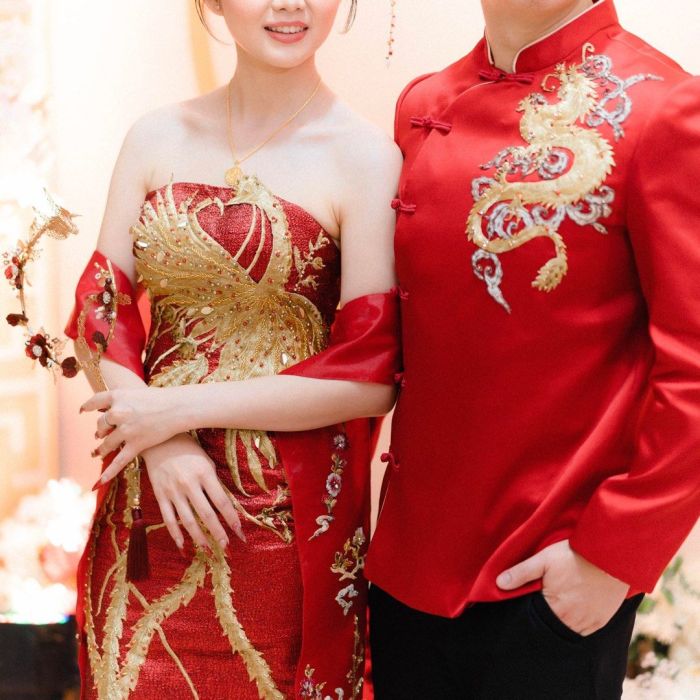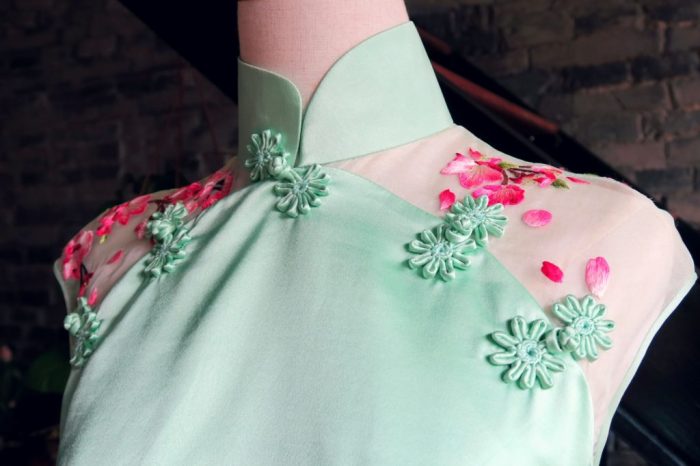Chinese Wedding Dresses: A Timeless Tradition
Chinese dress for wedding – The Chinese wedding dress, a symbol of tradition, beauty, and auspicious beginnings, holds a significant place in Chinese culture. From the vibrant hues to the intricate embellishments, the attire reflects centuries of evolving style and symbolism. This exploration delves into the diverse world of Chinese wedding dresses, examining their historical evolution, regional variations, and the enduring significance they hold in modern celebrations.
Traditional Chinese wedding dresses often feature vibrant colors and intricate embroidery. However, if you’re looking for a more formal Western style, consider the elegance of a black-tie gown; for plus-size options, explore the stunning collection at black tie wedding dresses plus size. Ultimately, the best choice depends on personal preference and the overall wedding aesthetic, whether it leans towards classic Chinese or contemporary Western styles.
Types of Chinese Wedding Dresses
Chinese wedding dresses encompass a captivating range of styles, blending traditional elements with modern interpretations. The classic Qipao, with its form-fitting silhouette and high collar, offers a sophisticated and elegant choice. Traditional wedding gowns, often featuring elaborate embroidery and symbolic motifs, showcase the rich heritage of Chinese craftsmanship. Modern interpretations cleverly integrate traditional elements into contemporary designs, resulting in unique and stylish ensembles.
| Dress Type | Common Embellishments | Typical Colors | Historical Significance |
|---|---|---|---|
| Qipao | Intricate embroidery, beading, delicate lace | Red, gold, ivory | Evolved from Manchu court attire, now a versatile symbol of elegance |
| Traditional Gown | Dragon and phoenix motifs, auspicious symbols, elaborate hand-stitching | Red, signifying good fortune and prosperity | Rooted in ancient Chinese traditions, representing marital bliss and longevity |
| Modern Interpretation | Subtle embroidery, minimalist designs, incorporation of Western elements | Variety of colors, including pastels and modern hues | Reflects contemporary fashion trends while retaining cultural elements |
The evolution of Chinese wedding dress styles reflects broader societal changes. Early dynasties saw simpler designs, evolving into the opulent and symbolic attire of later periods. The influence of Western fashion in the 20th century led to hybrid styles, a trend that continues to shape modern designs.
Fabrics and Materials
The choice of fabric for a Chinese wedding dress is significant, carrying symbolic weight and impacting the overall aesthetic. Traditional fabrics like silk and satin, known for their luxurious drape and rich texture, are favored for their association with prosperity and elegance.
Silk, particularly, is deeply symbolic, representing refinement, wealth, and good fortune. Satin, with its lustrous sheen, adds an air of sophistication. Modern fabrics such as lace and chiffon are also incorporated, offering versatility and a contemporary touch. The durability and drape of each fabric influence the final design and the overall comfort of the bride.
Color Symbolism in Chinese Wedding Attire

Source: karousell.com
Color plays a crucial role in Chinese wedding attire, conveying profound symbolic meanings. Red, the dominant color, is inextricably linked to good fortune, prosperity, and marital bliss. It signifies joy, happiness, and warding off evil spirits.
Other colors, while less prevalent than red, also carry significant meaning. Gold represents wealth and status, while ivory symbolizes purity and innocence. A visual representation could be a color wheel, with red at the center, surrounded by gold, ivory, and perhaps hints of other auspicious colors like pink (representing romance) and green (representing growth and vitality). Each color would have a brief description of its symbolic significance next to it.
Accessories and Jewelry, Chinese dress for wedding

Source: thepankou.com
Accessories and jewelry complement the Chinese wedding dress, enhancing its beauty and adding layers of symbolic meaning. These adornments are not merely decorative; they hold cultural significance and contribute to the bride’s overall appearance.
- Headdress: Often elaborate and adorned with auspicious symbols, reflecting the bride’s status and marital union.
- Jewelry: Jade, gold, and other precious stones symbolize wealth, longevity, and good fortune.
- Shoes: Traditionally red, symbolizing good luck and a prosperous future.
- Handbag: Often intricately embroidered, carrying symbolic items for the wedding ceremony.
A typical bridal headdress might feature phoenix and dragon motifs, crafted from gold, jade, and silk threads. These elements represent marital harmony and the union of yin and yang. The design is often intricate and elaborate, reflecting the importance of the headdress in the wedding ceremony.
Modern Trends in Chinese Wedding Dresses
Contemporary Chinese wedding dress designs showcase a fascinating blend of tradition and innovation. Modern designers often incorporate traditional elements such as embroidery or symbolic motifs into sleek, contemporary silhouettes. This fusion creates unique styles that resonate with modern brides while respecting cultural heritage.
The contrast between traditional and modern approaches lies in the silhouette and embellishments. Traditional dresses often feature fuller skirts and elaborate embroidery, while modern designs lean towards streamlined silhouettes with minimalist embellishments. However, both styles retain the core symbolism and cultural significance.
Regional Variations in Chinese Wedding Dresses
The vastness of China results in regional variations in wedding dress styles, reflecting diverse cultural practices and traditions. These differences extend to fabrics, colors, and embellishments, creating a rich tapestry of wedding attire across the country.
| Region | Dress Style | Common Fabrics | Typical Colors |
|---|---|---|---|
| Northern China | More elaborate embroidery and heavier fabrics | Silk, brocade | Deep reds and golds |
| Southern China | Lighter fabrics and simpler designs | Silk, chiffon | Brighter reds and pinks |
| Cantonese | Unique embroidery and color palettes | Silk, satin | Rich jewel tones and reds |
The Role of the Chinese Wedding Dress in Ceremony
The Chinese wedding dress is not merely an outfit; it is an integral part of the wedding ceremony, carrying immense symbolic weight. The dress embodies the bride’s transition into marriage, representing her new status and role within the family. The vibrant colors and auspicious symbols are believed to bring good fortune and blessings to the newlyweds.
The dress’s contribution to the cultural and symbolic aspects of the wedding is undeniable. It visually represents the union of two families and the commencement of a new chapter. The bride’s attire reflects her respect for tradition and her commitment to her new life as a wife.
Frequently Asked Questions: Chinese Dress For Wedding
What is the significance of the color gold in a Chinese wedding dress?
Gold symbolizes wealth, prosperity, and good fortune, making it a popular choice for embellishments or accents on Chinese wedding dresses.
Are there any specific etiquette rules regarding wearing a Chinese wedding dress?
While specific customs vary regionally, generally, it’s considered respectful to choose a dress that reflects the bride’s family heritage and to avoid overly revealing styles.
How long does it typically take to create a custom-made Chinese wedding dress?
The timeframe varies greatly depending on the complexity of the design and the tailor’s workload, but expect several months for a bespoke creation.
Can I rent a Chinese wedding dress instead of buying one?
Yes, renting is a viable option, particularly for less elaborate styles. Many bridal shops offer rental services for traditional and modern Chinese wedding dresses.